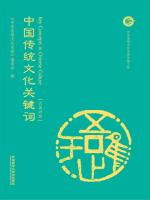中国传统文化关键词,我的启蒙典籍
用户866182
Having spent a considerable amount of time with "Key Concepts in
Chinese Traditional Culture" (though I must admit, I navigated
through it systematically rather than cover-to-cover), I find it to be
an exceptionally valuable and uniquely structured resource. This book, a
product of the prestigious "Chinese Thought and Culture Terminology
Dissemination Project," achieves something remarkable: it serves as
both a scholarly reference and an accessible gateway to the vast
universe of traditional Chinese philosophy and values. The book's core
strength lies in its format. By distilling Chinese traditional culture
into 100 key terms, presented bilingually in Chinese and English, it
provides a clear and organized framework for understanding. This is not
a sprawling historical narrative or a philosophical treatise arguing a
single point. Instead, it functions like a well-organized glossary or a
curated collection of foundational pillars. Terms like
"思想观念"and "价值体系"—which are also listed as the book's
tags—are not just categories for the book; they are the very subjects it
explores. This approach allows readers, whether native Chinese speakers
seeking a refined understanding or English-language learners curious
about the culture, to grasp complex ideas in manageable segments. The
editorial board, comprising esteemed scholars like Professor Yuan Jixi
and Professor Wang Bo, ensures the explanations are authoritative and
precise. However, this systematic approach is also the source of what I
might call a "divine anxiety," a phrase poignantly used by
another reviewer in the app. There is a certain tension in reducing a
culture's rich, often intuitive and context-dependent wisdom into
discrete, defined entries. The concise and objective language, while
excellent for clarity, can sometimes feel sterile, stripping away the
poetic ambiguity and historical debates that often surround these
concepts. Reading the book can feel like studying the architectural
blueprint of a magnificent temple—you understand the structure, the
load-bearing elements, and the layout perfectly, but you might miss the
experience of the incense smoke, the shadows on the stone, and the
feeling of reverence within its walls. It is a tool for understanding
the "what" and the "how," but the deep
"why" often requires the reader to venture beyond the text
itself. This is not a criticism of the book's goal, but rather an
observation on its best use. It is an unparalleled starting point. For
anyone—student, writer, or curious mind—wishing to avoid superficial
clichés about Chinese culture, this book provides the essential
vocabulary. It equips you with the precise definitions of concepts that
have shaped a civilization for millennia. The bilingual presentation is
particularly crucial for effective cross-cultural communication,
ensuring that translations are not just phonetic but carry the
conceptual weight of the original. In conclusion, my time with "Key
Concepts in Chinese Traditional Culture," even in a systematic
manner, was immensely productive. It is a book that demands to be used
as a reference, to be dipped into repeatedly, and to be used as a
springboard for deeper exploration. It may not offer the narrative
thrill of a novel, but it provides something more enduring: a solid,
reliable, and authoritative foundation for genuinely understanding the
key ideas that continue to influence Chinese thought and identity today.
It is a vital bridge between the depth of academic sinology and the need
for accessible public knowledge.



 京公网安备 11010802032529号
京公网安备 11010802032529号